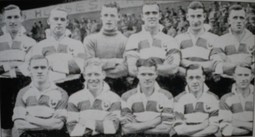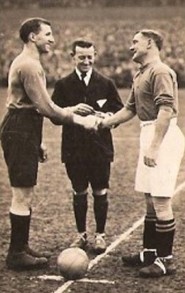 Whilst Tottenham have played in white shirts with navy blue shorts (or knickers as they were called till the late 1950’s) since 1898, the kit has evolved significantly over time with changes in fashion, practicality, technology and ultimately commercialism all having an impact on the design of the lilywhite shirt, evolving from the flannel/cotton button up shirts of Victorian times to today’s high tech, quick drying, moisture resistant, lightweight materials. Previously I had covered the period from 1945 to 1977, with this second article I will cover the inter-war period between 1918 and 1939 Between 1918 and 1921, Tottenham continued to wear a plain white cotton/flannel shirt with a collar and a buttoned placket down the front as they had pre-war, with navy blue knickers and navy blue stockings of varying design. For the 1921 Cup Final, when Tottenham won the FA Cup for the second time, a revolution in our kit history occurred. They introduced a new shirt, with a small collar and again a buttoned placket, and for the first time it sported a cockerel motif mounted on a shield on its left breast and, is possibly the first example in England of an "animal crest" being worn on a football shirt.  This first cockerel had a more "pumped up chest" than later designs and due to the success in the Cup Final, the crest became a permanent feature on Spurs' shirts from the following season. Sportswear manufacturer Bukta claim to have made all the 1920's Cup Final shirts, and as this shirt appears to be unchanged until the end of the '29/30 season, I presume that Bukta produced this shirt for this duration Top image - Away strip, 1937 -45 Left - Home 1918 - 1921  During the 1926/27 season, an alternate white home shirt was also used. This had no badge and was virtually collarless, with no buttons and was worn in at least three matches against WBA and Sunderland in September and West Ham in January. Whilst I cannot, as yet, ascertain what change kits Spurs wore immediately after the First World War, a navy blue and white vertical striped shirt with a laced up “grand-dad” collar was worn against Bolton and Preston 1920/21. Right - Away strip 1920 - 21 This was replaced by a plain red shirt for that seasons FA Cup semi-final again against Preston (who wore blue shirts)and was worn until at least 1924 when a change was required For the 1922 FA Cup semi-final also against Preston at Hillsborough, Sheffield, Spurs wore blue and white vertical stripes, with the blue being lighter than that of their knickers. Now as Preston played in red shirts that day, I believe that these shirts were in fact borrowed from their hosts Sheffield Wednesday, presumably as Spurs had traveled with the red shirts they had worn the previous year  For the 1930/31 season, Spurs introduced a new shirt that was made of a cream/off-white material, with a pure white collar. According to a contemporary report in the Tottenham Weekly Herald, unusually this shirt was made of cashmere wool and turned off white after washing. I can find no reason for the use of this unusual and now luxurious material. Left - 1930 and the cashmere shirt. These shirts seem to have been dropped some time after Christmas 1930, but were used again early in the 1933/34 season. This shirt also introduced a new badge, still a cockerel and shield motif, but with a cockerel that was more "flat chested" than the previous design.  The cashmere shirt was replaced sometime after Christmas in the 1930/31 season with a pure white and presumably cotton shirt that had a much deeper placket down to level with the bottom of the new "flat chested” badge. This was worn until the end of '33/34 season and, occasionally for the following three seasons. It was replaced for the 1934/35 season by an identical shirt except that it had a shallower placket that stopped around level with the top of the badge. Right- Home, 1921 -30  Whilst Spurs had worn a narrow hooped change shirt in November 1925, from at least 1928, they adopted a change shirt of broad navy blue and white hoops, and they continued to wear this design when a change was required ,through till 1947. Like the white home shirt, whilst the design was ostensibly the same, there were variations along way, again most likely due to different batches and manufacturers. Initially the shirt did not have a badge, but for the 1933/34 season, the hoops were reversed from the previous design and it carried a badge on the white hoop. For the1937/38 season, the hoops were again reversed, with badge in the same place, but now on a blue hoop. Some of these new shirts were the new Umbro Tangeru design, more of which later. left - Away - 1920 -24 Despite having a standard change kit during this period, between 1930 and 1937, a myriad of alternative one off change kits also appeared. For the FA Cup match against Preston at White Hart Lane in January 1930, red and white stripes are shown to have been worn, then in 1932/33, sky blue is shown to have been worn away to Bury and news reel footage of the FA Cup defeat to Luton Town, shows Spurs in red shirts, navy blue knickers and navy blue stockings with red turn overs! Then finally for two games at White Hart Lane against Preston and Swansea on consecutive weekends in February and March 1937, they wore red shirts complete with cockerel badge and white knickers.  The final shirt for this period, was introduced at the start of the 1937/38 season and for the first time in Tottenham’s history was produced by Umbro, starting a forty year relationship. This was known as a Tangeru shirt, being distinguished by the large re-enforcement at the bottom of the placket. This is probably the longest single design of shirt used in Tottenham’s history and was used till 1956 Left - Away -1925-26  Umbro had introduced this design of shirt for the 1934 FA Cup Final when Manchester City took to the Wembley pitch wearing these innovative new kits, stylishly tailored from Peruvian pima cotton, an innovative soft fabric that Umbro would advertise as ‘Tangeru’ it was dubbed “the new fabric for football jerseys”. Right - Home kit - 1934 -37 The final innovation on this shirt before the war, came in January 1939 for matches in the FA Cup, when teams were required to have numbers on the back of their shirts for the first time. These numbered shirts were then used in the Football League from the start of the 1939/40. Then bigger events overtook all such matters.
author - Tony Sealey Part 3 - Looks at the period 1882 -1914 Editor’s note – Tony is a lifelong Spurs supporter and has a wealth of knowledge regarding the club and we are delighted he has managed to find the time to share with us this series on his specialist subject, the kits worn by the team, as well as some of his many images. Please also remember he has offered to answer any questions you may have, you can add them in the comments below or on Facebook. Thank you. The HFK website Tony refers to is - http://www.historicalkits.co.uk/
1 Comment
keith
9/3/2017 01:18:30 pm
http://www.indiaspurs.com/blog/talking-tottenham-with-tony-sealey
Reply
Leave a Reply. |
Features
Flying Down to Rio History of T.H.F.C. Tribute to Bill Nicholson Talking Tottenham Early Legends The Road to Turin International Connections Hotspur Towers Most Read Articles
The 100 Year War Interview with Marina Sirtis A Long Dark Shadow By Royal Appointment School Report: An Insight into the Younger Eric Dier Dear Jimmy All Change At Spurs Hotspur Towers History Of THFC: Part 1 Passage to India: Rohan Rickets Thanks For The Memories Our Tommy Carroll The AVB Files: Part1 The Lilywhites You The Jury The Hand Of Hugo Connection - Argentina Creating a Reputation One Hotspur Archives
August 2018
Categories
All
|
 RSS Feed
RSS Feed

